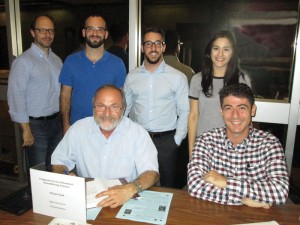
Photo: Barlow Der Mugrdechian
Michael Rettig
Staff Writer
Memory and the search for origins is an important facet in the understanding of one’s identity. To appreciate and internalize one’s past and history is to honor one’s ancestors and the struggles that they faced.
Dr. Armen Marsoobian, Professor and Chair of Philosophy at Southern Connecticut State University, was able to share his personal journey into his origins with a lecture at Fresno State on Tuesday, September 15, titled “Memory, Memorialization, and Bearing Witness: Contested Memories of the Armenian Genocide in Turkey.” The presentation was part of the Fall Lecture Series of the Armenian Studies Program, and was supported by the Leon S. Peters Foundation.
As a philosopher, Dr. Marsoobian has always had an interest in his roots. “I think that part of what I’ve always been engaged in is a reflection on where we come from, what our origins are.” He first became inspired to dig deeper into his past when he was invited to Anatolia College in Marsovan, Turkey, where his grandfather, Tsolag Dildilian, was the photographer in 1894. This visit prompted Dr. Marsoobian to embark on two simultaneous journeys; the first, his personal journey in discovering more about his family’s past, and the second, an “intellectual journey” to determine what he ought to do with the memories he unearthed.
“I soon came to realize that the stories I uncovered had an important moral dimension. My ancestors, in recording their story, in both words and images, were bearing witness to the unjust suffering and harm they had undergone. It thus became my moral duty to tell their story, and by so doing, acknowledge their suffering.”
Dr. Marsoobian believes that it is his obligation to share his findings with the perpetrators. He partnered with a Turkish NGO that is dedicated to using the arts to advocate for social issues, including alleviating the animosity felt between Turks and Armenians around the world. They organized photography exhibits in Istanbul, Diyarbakir, and Marsovan that attest to the Armenian experience in Ottoman Turkey. These photo exhibits allow Turks and Kurds who know very little of the ancient Armenian existence in Anatolia to learn about that history.
Dr. Marsoobian is also partnering with locals in Marsovan to identify buildings, such as homes, churches, and businesses, with historical significance to Armenians. His goal is to attach plaques to these “Memory Sites” to bear witness to the lost memories and histories of these buildings. He has identified the former homes of Armenian professors and intellectuals with the hopes of purchasing them from the city. Dr. Marsoobian has also been able to track down his grandfather’s home in Marsovan by using the family’s photos.
“Our memory projects are designed to reach the individual Turkish citizens in such a way as to change the collective memory of Turkish society. The ultimate goal is to encourage Turks to take responsibility for their nations past, and in so doing, to collectively do justice to that past.”
To conclude his lecture, Dr. Marsoobian showed a sample of his grandfather’s photos from Marsovan and their journey to Greece. It was his grandfather’s occupation as a photographer that ultimately preserved his life during the Genocide, as the Turks had need of his skills, and it was his grandfather’s photos that helped preserve their family’s story. Dr. Marsoobian has been able to use his family’s story to better understand his own past and to aid those who have forgotten an understanding of their own history.
 Hye Sharzhoom Armenian Action
Hye Sharzhoom Armenian Action